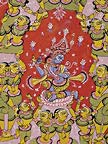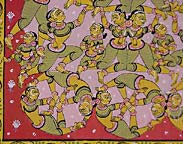V. Themes from Folklore and Erotic Themes1. Themes from folklore: nava-gunjara Pata-chitras based on folklore include paintings of Manasa, a snake goddess
popular in parts of Orissa and especially Bengal, and of the nava-gunjara
theme, in which Vishnu or Krishna is shown as a composite creature of
nine different animals (Mohanty, 1980, p.10). An example of the latter
is shown in Figure 31.
In this painting of the nava-gunjara, Arjuna stands before Vishnu in the composite form of nine animals. In the Bhagavad Gita, part of the epic Mahabharata, there is a point in the discourse between Arjuna and Krishna wherein Arjuna asks the Lord for a vision of his true form. Krishna grants this vision, both glorious and terrifying, in which Arjuna sees the entire universe inside Krishna. This great form of Krishna is called virat-rupa (omnipresent or vast form). A variant of this in Orissa is the nava-gunjara, or a composite form of nine animals (Swali & Swali, 1984, p.24). 33
In a rendition of the Mahabharata (which, as noted, includes the Bhagavad Gita) by the fifteenth century Oriya poet Sarala Das, several episodes are added beyond those found elsewhere in India. In this telling of the tale, Vishnu himself proceeds to a hill where Arjuna is doing penance in a forest. Here, Vishnu reveals himself to Arjuna in the nava-gunjara form, a vigorous animal standing on three legs, those of the elephant, tiger, and horse. The fourth limb is not an animal leg, but an upraised human arm, the hand of which is holding a lotus flower. Besides these four creatures, Vishnu-nava-gunjara also has the head of a rooster, the neck of a peacock, the hump of a bull, and the waist of a lion. A snake comprises the tail. When Arjuna saw this creature, he immediately recognized it as the virat-rupa of Vishnu-Krishna. He threw aside the bow and arrows he had been carrying, folded his hands, and invoked the Lord's blessing (Swali & Swali, 1984, p.24).
Thus, in this painting, we see the various aspects of this story. There is the aggregate creature composed of the nine animals as described by Sarala Das. We see the creature's human hand holding the lotus, elephant leg on the ground, and peacock neck and rooster head facing Arjuna. We see vegetation - admittedly, rather sparse - representing the forested hilltop of Arjuna's penance. Arjuna's bow and arrow lie on the ground at his side. Arjuna himself, crowned, stands with folded hands before Vishnu, whom he has recognized. (See the close-up in Figure 31a, above.) The horse and tiger hind legs of the nava-gunjara are detailed in Figure 31b left, as well as the waist of the lion, hump of the bull, and serpent tail. In this picture, we also see the typical double border, the outer wider border with a wavy leaf design and the inner with a design of arcs or semicircles. Note too that this picture is "out of square"; more a parallelogram than a rectangle. This is true both of the borders and of the outer edge of the cloth itself (not clearly visible in Figure 31). Such angled lines and cuts are frequent in pata-chitras. |






